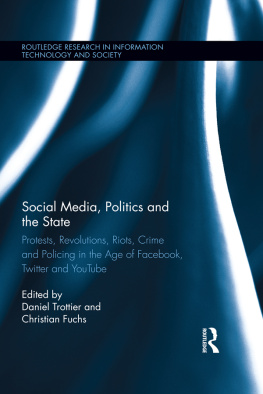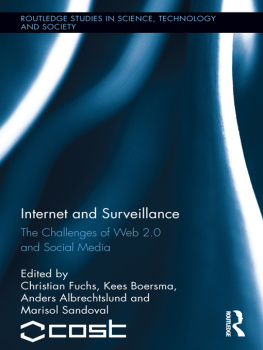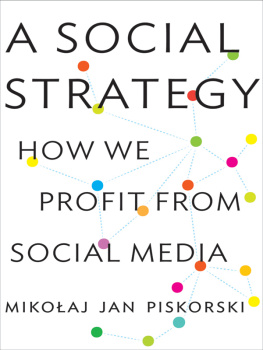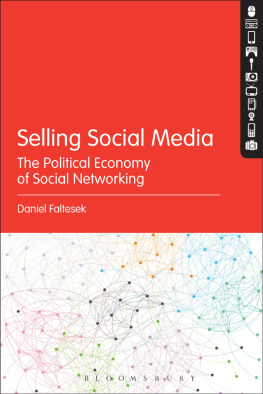SOCIAL MEDIA AS SURVEILLANCE
Social Media as Surveillance
Rethinking Visibility in a Converging World
DANIEL TROTTIER
Uppsala University, Sweden
ASHGATE
Daniel Trottier 2012
All rights reserved. No part of this publication may be reproduced, stored in a retrieval system or transmitted in any form or by any means, electronic, mechanical, photocopying, recording or otherwise without the prior permission of the publisher.
Daniel Trottier has asserted his right under the Copyright, Designs and Patents Act, 1988, to be identified as the author of this work.
Published by
Ashgate Publishing Limited
Wey Court East
Union Road
Farnham
Surrey, GU9 7PT
England
Ashgate Publishing Company
Suite 420
101 Cherry Street
Burlington
VT 05401-4405
USA
www.ashgate.com
British Library Cataloguing in Publication Data
Trottier, Daniel.
Social media as surveillance: rethinking visibility in a converging world.
1. Social media. 2. Facebook (Electronic resource) 3. Electronic surveillance.
I. Title
303.4833-dc23
Library of Congress Cataloging-in-Publication Data
Trottier, Daniel.
Social media as surveillance: rethinking visibility in a converging world / Daniel Trottier.
p. cm.
Includes bibliographical references and index.
ISBN 978-1-4094-3889-2 (hbk) ISBN 978-1-4094-3890-8 (ebook) 1. Online social networks. 2. Social media. 3. Internet--Social aspects. 4. Electronic surveillance. 5. Eletronic intelligence. 6. Privacy, Right of. I. Title.
HM742.T76
ISBN 9781409438892 (hbk)
ISBN 9781409438908 (ebk-PDF)
ISBN 9781409484264 (ebk-ePUB)

Printed and bound in Great Britain by the MPG Books Group, UK.
Contents
Acknowledgments
This work would never have come to fruition without support from the following individuals. I am deeply indebted to David Lyon. Your mentorship and unwavering encouragement are the reasons why I chose to pursue and was able to complete this research. But your guidance went beyond academic concerns, and this is no more evident than in the success and happiness of your former and current students. This project would be severely lacking without Martin Hands continued encouragement. Your office door was always open, you trusted me to teach your courses, and you were willing to lend books that you had just obtained. I am also grateful for Vincent Moscos contributions through supervision and teaching. You have fostered a wealth of perspectives for me to approach my research, but have kept a sharp eye on the underlying concerns and relevance. This produces a sociology that is as nuanced as it is assertive.
I am extremely thankful for Laura Murrays interest and patience throughout this project. Likewise, Rob Beamish has helped tremendously by holding my work to a high standard during my time as a doctoral student. Mark Andrejevics contributions through published research as well as direct feedback have also been invaluable. I would not be in this field were it not for all the stellar individuals in Surveillance Studies at Queens University and abroad. I am especially grateful for Kevin Haggertys guidance during the transition from graduate student to post-doctoral fellow, and Christian Fuchs support in my continued journey as a postdoc. This book was also made possible thanks to the Department of Sociology at Queens University, the Blakely Fund, the Ontario Graduate Scholarship, and the Social Sciences and Humanities Research Council.
This project was greatly enriched by all the friends and colleagues I met as a graduate student and postdoctoral fellow. I am honoured to include you in my social network, and have every confidence in your future accomplishments. Finally, this book would not be possible without my familys confidence and patience. Thank you.
Chapter 1
Introducing Social Media Surveillance
Introduction: Dwelling in Social Media
Social media complicates relations between individuals, institutions, businesses and police, by acting as a platform where all these groups converge. This book looks at the rise of surveillance practices on social media, using Facebook as a case study. Drawing on in-depth interviews with different types of users, it underscores new practices, strategies, concerns and risks that are a direct consequence of living on social media. Recent scholarship has considered social change stemming from social media (Miller 2011, Turkle 2011). These works point out the way that social relations are transformed by virtue of being mediated on platforms like Facebook. Issues of privacy, exposure and visibility clearly matter in these studies. This book follows from these concerns by concentrating on the process by which users manage their personal information on social media, while taking advantage of the information that others put up.
People increasingly live their lives on social media, suggesting that these services are a kind of dwelling. Framing social media as dwellings leads to several questions: Who lives on Facebook? How do they interact with each other? How does this co-habitation impact how they share their lives? This chapter addresses issues of exposure and visibility on social media, including the seemingly conflicting desires for privacy and publicity. It argues that different groups dwelling on Facebook lead to a mutual augmentation of their surveillance practices, a claim that is substantiated in later chapters. This chapter locates social media surveillance alongside scholarship on social media in general, as well as other types of new media.
I had the pleasure of spending my twenty-ninth birthday in an airport. If nothing else, this experience was a great thought exercise. Airports are transitory non-spaces. We use them as a means to connect with others. An increased reliance on airports produces the feeling that we dwell too much in them, rather than the locations that they connect. This becomes an opportunity to reflect on transient communities, and the importance of maintaining social ties. Most of the important people in my life are scattered around the world. While thinking about this distance, I began to receive notices on my phone, all of which directed me to birthday wishes on my Facebook wall.
These messages persisted for the rest of the day. I began to wonder: what if these were guests at a birthday party? I would need to rent a large hall, for one thing. Also, there would be potential for social discomfort. Work colleagues would be mixing with high-school friends, exes, and family members. Worlds would collide. What kinds of problems would arise? More specifically, what kinds of exposure would come from this? These concerns are not rooted in speculative fiction. Social convergence is a reality: it is a condition with which social media users cope.
Scholars commonly talk about social media as a kind of digital space. But based on its uptake, we can take this description further in saying that it is a kind of dwelling. We live through social media, and we live on social media. Moreover, this dwelling is characterized by social convergence, and this social convergence has distinct effects on our visibility. Social convergence refers to the increased social proximity of different life spheres. This provokes discomfort because we maintain different representations of ourselves, and these may clash or directly contradict one another. This discomfort suggests that we live compartmentalized lives, and that we perform differently in each context. Whereas most online spaces maintain these borders, social media, and Facebook in particular, are eager to demolish them. Social media like Facebook have the effect of making different fragments of our lives visible to all other fragments. If I solicit career advice on my Facebook wall, this may provoke a debate between an unusual assembly of social ties. Moreover, details from these various spheres are likely to leak elsewhere. Users are not prepared for this kind of exposure.
Next page








